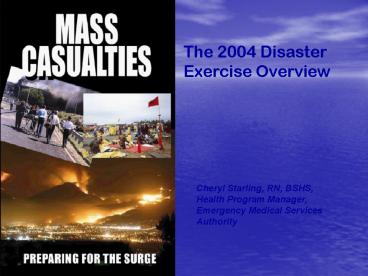2003 Statewide Medical and Health Disaster Exercise - PowerPoint PPT Presentation
1 / 24
Title:
2003 Statewide Medical and Health Disaster Exercise
Description:
Cheryl Starling, RN, BSHS, Health Program Manager, Emergency Medical Services Authority ... Cheryl Starling, RN. Disaster Medical Specialist. California EMS ... – PowerPoint PPT presentation
Number of Views:33
Avg rating:3.0/5.0
Title: 2003 Statewide Medical and Health Disaster Exercise
1
The 2004 Disaster Exercise Overview
Cheryl Starling, RN, BSHS, Health Program
Manager, Emergency Medical Services Authority
2
2004 Statewide Medical and Health Disaster
Exercise
Cheryl Starling, RN Disaster Medical
Specialist California EMS Authority
3
Exercise History
- This is the 6th annual exercise!
- Past Exercises
- 1999 Y2K
- 2000 Earthquake, chemical spill, train
derailment, tsunami - 2001 Chemical (terrorism)
- 2002 Radiological (terrorism)
- 2003 Plague (terrorism)
- 2004 Botulinum (terrorism)
4
Exercise Development
- Exercise Planning Committee
- Members from
- Public and Private Organizations
- Planning begins in January
- Scenario is developed and refined
- Exercise Contact for each OA identified
- Guidebook is created and released in July
5
Exercise Day
- November 18, 2004
- 800 am until 1200 pm
6
Exercise Guidebook
- Written to guide participants
- Reporting participation
- Intent to Participate
- OA Intent to Participate
- Exercise Participant Evaluation Forms
- Hospital facility
- Other healthcare provider/facility
- Ambulance
- ACS
- Public Health
7
Exercise Guidebook
- Reference Materials
- Tips for hospitals
- Glossary
- FAQs about Botulinum
- OA Exercise Contacts
8
Exercise Contacts
- Each OA appoints an Exercise Contact
- Role of the OA Exercise Contact
- Coordinate the exercise for the OA
- Bring agencies and participants together for
planning and preparations - Act as liaison between OA and region
- Act as problem solver before and during exercise
- Orchestrate the hotwash (debriefing)
9
Exercise Objectives
- Exercise Objectives for participants
- Hospitals
- Ancillary Healthcare Facilities
- Ambulance
- ACS
- OA Emergency Operations Center
- Local Public Health
- State Agencies
- Add your own objectives!
10
2004 Exercise
- The Annual Jubilee is November 17, 2004
- At 500 am, cases begin presenting to the ED
- Sudden onset of dizziness
- Blurred vision
- Slurred speech
- Difficulty swallowing
- Nausea
11
2004 Exercise
- Suspected Clostridium botulinum
- Patients begin arriving with symptoms
- Issues are
- management and allocation of
- scarce resources!
12
2004 Exercise
- Healthcare system overwhelmed with critical
patients and a lack of resources including - Healthcare personnel
- Equipment
- Supplies
- Bed capacityespecially ICU
13
2004 Exercise
- The scenario spurs you into action
- A number of patients are presenting to the local
community clinics wanting to see the doctor with
complaints of dizziness, weakness and facial
drooping. There are several patients that
require immediate care at the clinic and 9-1-1 is
called to transfer them immediately to the ED.
Unfortunately, EMS is overtaxed with calls, and
cannot get to the clinics immediately. - What communication mechanism does the clinic have
with the acute care hospital to alert them of
incoming patients? - What internal procedure(s) or plan(s) should the
clinic activate in this situation? - What other resources does the clinic require for
the patient until EMS can arrive to transport the
patients to the acute care hospital? - How does the clinic communicate with local public
health to notify them of the patients and to
receive assistance?
14
2004 Exercise
- Participants will exercise
- Policy and procedure for communicating to health
departments and healthcare providers - Management of scarce resources
- Cooperation with public and private community
organizations - Collaboration with inter-agency PIOs to
coordinate risk communication
15
The Exercise Cycle
- Planning
- Preparation
- Execution
- Post exercise activities
16
2004 Exercise
- Certificate of Participation
- Issued when exercise evaluation form completed
and - returned to EMSA
17
2004 Exercise
- Developing the After Action Report
- Informal debriefing or hotwash
- Immediately post-exercise
- What worked?
- What did not work?
- Improvements to be made?
- Document critique!
18
After Action Reporting
- A written record of your exercise!
- Report should address
- The objectives were met/not met
- Achievements
- Areas to improve
- Strategies for the future
- Outlines the ACTION PLAN
- For plan revision and additions
- For future exercises and activities
- Documentation for accreditation agencies!
19
After Action Reporting
- Share the information!
Internally Board of Directors CEO Disaster
Committee Safety Committee Staff
Externally Fire EMS Community Emergency Planners
20
- Follow up is the
- Test of success!
21
Follow Up Actions
- From Soup to Nuts!
- Purchase new equipment
- Provide more training
- Revise existing policy
- Create new policies
- Over haul the entire disaster plan ?
- Implement HEICS ?
- Have another exercise
22
Exercise Guidebook
- Download from the
- EMSA website at
- www.emsa.ca.gov/dms2/hospambex.asp
23
The End !
24
Contact Information
Cheryl Starling, RN Disaster Medical
Specialist CA EMS Authority 916-322-4336
cheryl.starling_at_emsa.ca.gov































